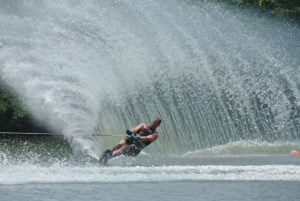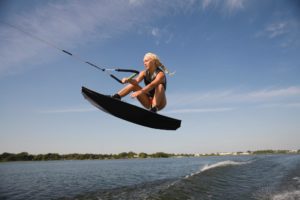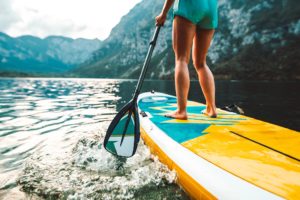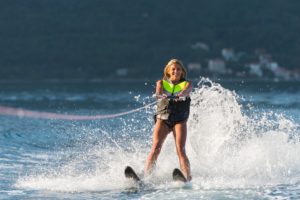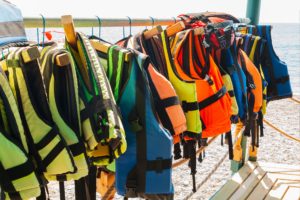There are several reasons to start windsurfing. To challenge yourself, try something new, for exercise, to get outside and for the thrill of zipping across the water. The most important reason is that you will have a lot of fun when doing it. Below is some helpful advice and tips that will help you to get started windsurfing!
The background of windsurfing
Windsurfing sparked in the late 80s and 90s. Pros like Robby Naish, Bjorn Dunkerbeck, and numerous other legends have carved their names in windsurfing history and inspired others to venture into the sport. These athletes have drawn windsurfers to try different types of windsurfing including waves, freestyle, and course racing. Since then, windsurfing has evolved tremendously. With today’s gear being lighter, faster, simpler, easier, and cheaper, NOW IS THE BEST TIME TO LEARN!
Evolution of windsurfing
In the past, windsurfing boards were long, narrow and quite tippy. Now, they are shorter, wider, and provide much more stability. These factors are making the whole sport more user-friendly and easier to learn. Today’s windsurfing sails are much lighter due to materials like carbon and monofilm. Entry level sails are shorter and more reliable, making them easier to pull out of the water and less likely to tear or rip. This sport has become much cheaper over the years, gear improvements make items last longer, and the wind is always free. Windsurfing also doesn’t require expensive gas or lift tickets. Another benefit is that you can do it almost anywhere! You don’t have to be on a tropical vacation in Hawaii or the Caribbean. People of all ages are able to windsurf, kids as young as three and adults as old as 80 alike.
What to expect
Windsurfing is a water sport that brilliantly combines aspects of surfing with sailing. It consists of a wind-powered sail that is attached to a board. Like most things in life, starting out is the hardest part. There are going to be times when you are going to be frustrated, mad, and might even want to give up. Unable to keep balance, not correctly positioning the sail, and falling can make it a challenging time. Being persistent, patient, and just a little stubborn is the key to success in learning how to sail. Since it is challenging to learn, once you get the hang of it, it’s extremely rewarding. I am not telling you this to try and discourage you from learning but as a warning of what to expect. I urge everyone who is trying to learn to stick with it, even if it might be rough at first. Once you get a handle on the basics, you will enjoy every second you are out on the water.
What you need to know to get started windsurfing
There are lots of things to learn before you get on the water. You need to be able to set up a sail before you can get out windsurfing. To do this, you need to have an understanding of the gear that makes up the rig. The first thing an instructor might teach you about is the individual parts. Windsurfing has a lot of unique pieces that when properly put together, creates an impressive sail that can harness the power of the wind. You can check out our entire windsurfing store [HERE].
So what about the wind?
The next thing to learn about is how the wind influences the direction of the windsurfer. The sail is how you steer and determines your direction. Generally, you will be sailing perpendicular to the wind, with your back always to the wind until you turn. Depending on how you position the sail you can shift the direction of the board. Tip the sail back towards the fin, and you will turn up into the wind. Tip the sail forwards towards the bow, and you will turn down and away from the wind.
Getting a Windsurfing lesson can be a huge help!
Now that you have decided that you want to learn to windsurf, it’s strongly advised you find a professional instructor to start. Windsurfing is an extremely technical sport and it is easy to form bad habits or develop improper technique. Sure, you can teach yourself to windsurf. You could also teach yourself to fly a helicopter, but you probably wouldn’t. You can save yourself hours of frustration, by learning from a certified instructor. They will teach you the basics and make sure you are having a good time. There are countless videos on YouTube that give quality information, on how to get started windsurfing, to help you along. Watching this before a lesson would be a good preview of what one might be like. Learning to windsurf from a friend or family member can be a good option. Depending on where you are located finding a quality instructor may be challenging.
Things to consider
There are a lot of factors that can either make or break a fun day of windsurfing. Windsurfing is heavily dependent on the weather. The ideal wind speed for learning is around 5-15 miles per hour. This will give you enough power to keep moving, but not too much where you can be overpowered. Too little wind will be unproductive, and you will be unable to sail. Too much wind can be overwhelming, and make you feel out of control. The ideal spot for windsurfing is a body of water that has land on at least two sides and has easy entry and exit points. You want to avoid steep and or rocky locations that might damage your gear.
Windsurfing Gear
When you’re ready to purchase your own gear, your best bet is a package. Combinations can range in price, typically $900 and up. Your equipment can last a very long time if you care for it properly.
Windsurf Boards: Beginners are advised to get a board that is at least 80cm wide or more, this will help provide stability, and allow for better balance. The next thing to consider is the volume, less volume means it will sink lower in the water, while higher volume means it will have more float. As you progress your skills, you will move to smaller boards. Make sure your first board has a retractable centerboard or center fin, this makes it easier to sail upwind. It will allow you to have more control over your sailing direction. A padded EVA foam deck is a good thing to have on your first set-up. Your body, especially your knees, will thank you for having this soft deck to climb up on, rather than the hard surface that more advanced boards often have.
Windsurf Sails: When trying to decide what sail to use, start out with a smaller one. It’s recommended you choose a sail smaller than 5.0 if you are learning. Smaller sails are the best for training because they are light, easy to maneuver and have better control. Once you get the hang of manipulating the sail, you can move to larger and heavier sails.
You may also want to consider some additional items to make your experience better. A wetsuit will keep you comfortable, should you choose to conquer cold waters. Lifejackets or vests are recommended to keep you safe when you take the inevitable beginner tumble. You will also need a mast, mast base and boom, however, those will more than likely be included in your starter package.
Windsurfing is a great sport that is fun for everyone. Almost anyone can learn to windsurf and have a blast while doing it. New revolutionary sailing technology has now made it the best and easiest time to learn. This wind-based sport will test and push your skills to new heights. Take advantage of the warm weather and get out windsurfing this summer!
Kylan J.




